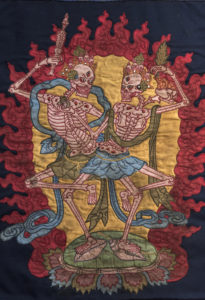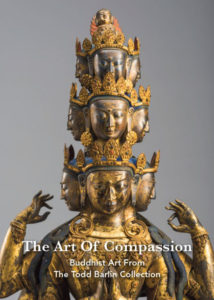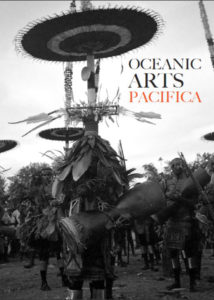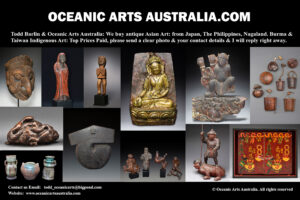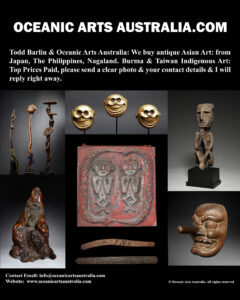A Superb Mongolian Cloth Applique Thangka Depicting Dancing Citipati
| Collection No. | SOLD but see lots more Fine Oceanic & Aboriginal Art on my website |
|---|---|
| Size | Entire Cloth Size 101cm x 59cm and Citipati Image only 53cm x 41cm |
A Superb Mongolian Cloth Applique Thangka Depicting Dancing Citipati
This finely sewn Mongolian Buddhist Cloth Applique Thangka depicts dancing Citipati Deities. The skeleton figures, representing worldly spirits, in Tibetan Cham dances are often seen as jesters or servants for other minor worldly gods such as Yama. These Cham dancing skeletons, like the other characters found in dance such as the deer and yak-headed servants of Yama, are generally only found in narrative vignettes if found at all in Tibetan paintings. The most common dance represented in painting is generally known descriptively as the Black Hat Dance and specifically understood to be the Vajrakilaya Cham dance. There will, of course, be images or random skeletons found in wrathful deity paintings or in the many depictions of the charnel grounds where the relevant Sanskrit and Tibetan texts explicitly state that skeletons are found in cemeteries” Jeff Watt 4-2004 Himalayan Resources
Thangka appliqué is a technique of creating thangkas using not paint, but cloth and precious silk. Just like thangka paintings, thangka applique is a sacred art, and appliqués follow the iconography for Buddhist deities as laid down in Buddhist scripture. The art of appliqué first began among the Huns of Central Asia to embroider saddle blankets. Gradually, it spread east across the Silk Road and was adopted by Tibetans and Mongolians as religious art.
Provenance: The Todd Barlin Collection of Buddhist Art and Asian Arts
Exhibited: The Art of Compassion: Buddhist Art from the Todd Barlin Collection 2018
See my new EXHIBITIONS GALLERY showing the Museums and Art Galleries Exhibitions that I provided artworks for over the past 40 years. There is the link to the article about my artworks published in the prestigious Louvre Magazine in 1996
I have artwork for Museums and art Galleries but also for collectors at every stage of their collecting. I want to encourage people to explore the fine art of New Guinea & West Papua and the Pacific Islands and to be able to see and touch the artworks in a relaxed and friendly manner in my Sydney Gallery. I would like to invite you to visit my gallery and see the artworks in person and also look at my website www.oceanicartsaustralia.com where there are many Galleries & Sub Galleries to explore.
My Gallery of nearly 40 years is the last physical gallery in Sydney that specializes in New Guinea and Oceanic Art. Sydney is very close to New Guinea & the Pacific Islands where all of these amazing artworks came from, Australia’s closest neighbors.
To see many more rare items and the finest masterpieces, please make an appointment with us to visit the gallery.
For all inquiries, please contact us

